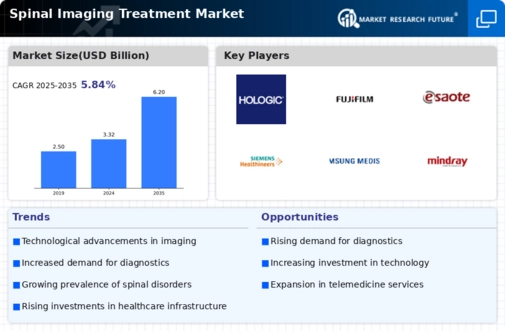Increasing Healthcare Expenditure
Rising healthcare expenditure across various regions is a crucial driver of the Spinal Imaging Treatment Market. As governments and private sectors allocate more resources to healthcare, there is a corresponding increase in funding for advanced diagnostic technologies. This trend is particularly evident in developed economies, where healthcare budgets are expanding to accommodate innovative imaging solutions. Market data suggests that the demand for spinal imaging services is likely to rise in tandem with increased healthcare spending, as patients gain better access to high-quality diagnostic tools. This financial commitment to healthcare infrastructure is expected to foster growth in the spinal imaging sector, as facilities upgrade their capabilities to meet patient needs.
Rising Incidence of Spinal Disorders
The increasing prevalence of spinal disorders, such as herniated discs and spinal stenosis, is a primary driver of the Spinal Imaging Treatment Market. According to recent data, approximately 80 percent of adults experience back pain at some point in their lives, leading to a heightened demand for effective diagnostic imaging solutions. This trend is further exacerbated by an aging population, as older individuals are more susceptible to spinal issues. Consequently, healthcare providers are increasingly investing in advanced imaging technologies to enhance diagnostic accuracy and treatment planning. The growing awareness of spinal health and the need for timely interventions are likely to propel the market forward, as patients seek out specialized imaging services to address their conditions.
Growing Focus on Preventive Healthcare
The increasing emphasis on preventive healthcare is shaping the Spinal Imaging Treatment Market. As healthcare systems worldwide shift towards proactive management of health conditions, the demand for early detection of spinal disorders is rising. Preventive imaging plays a crucial role in identifying potential issues before they escalate into more severe conditions. Market analysis suggests that the preventive imaging segment is projected to grow significantly, as patients and healthcare providers recognize the value of early intervention. This trend is further supported by initiatives aimed at promoting spinal health awareness, which encourage individuals to seek regular check-ups and imaging assessments, ultimately driving market expansion.
Technological Innovations in Imaging Techniques
Technological advancements in imaging modalities, such as MRI and CT scans, are significantly influencing the Spinal Imaging Treatment Market. Innovations like high-resolution imaging and 3D reconstruction capabilities have improved diagnostic precision, allowing for better visualization of spinal structures. The introduction of portable imaging devices has also expanded access to spinal imaging services, particularly in remote areas. Market data indicates that the MRI segment is expected to witness substantial growth, driven by its non-invasive nature and superior imaging quality. As healthcare facilities adopt these cutting-edge technologies, the overall efficiency and effectiveness of spinal diagnostics are likely to improve, thereby stimulating market growth.
Integration of Artificial Intelligence in Imaging
The integration of artificial intelligence (AI) into imaging technologies is revolutionizing the Spinal Imaging Treatment Market. AI algorithms enhance image analysis, enabling faster and more accurate diagnoses of spinal conditions. This technological synergy not only improves patient outcomes but also streamlines workflow in healthcare settings. Market forecasts indicate that AI-driven imaging solutions are likely to gain traction, as they assist radiologists in identifying abnormalities with greater precision. The potential for AI to reduce diagnostic errors and optimize treatment plans is expected to attract significant investment in this area, further propelling the growth of the spinal imaging market.



















Leave a Comment